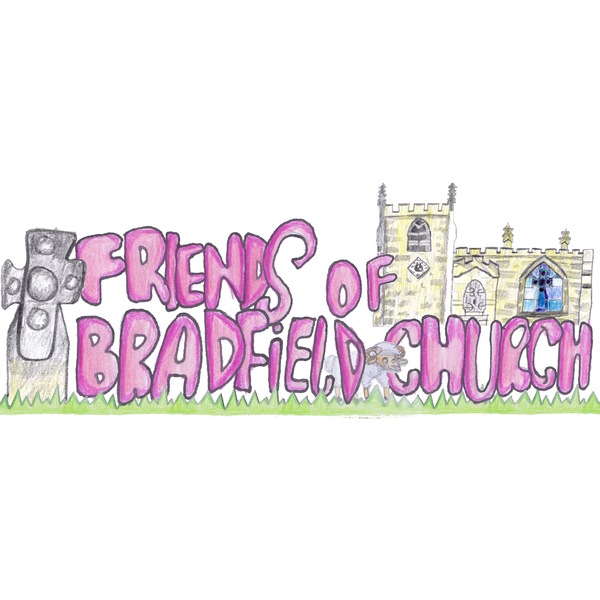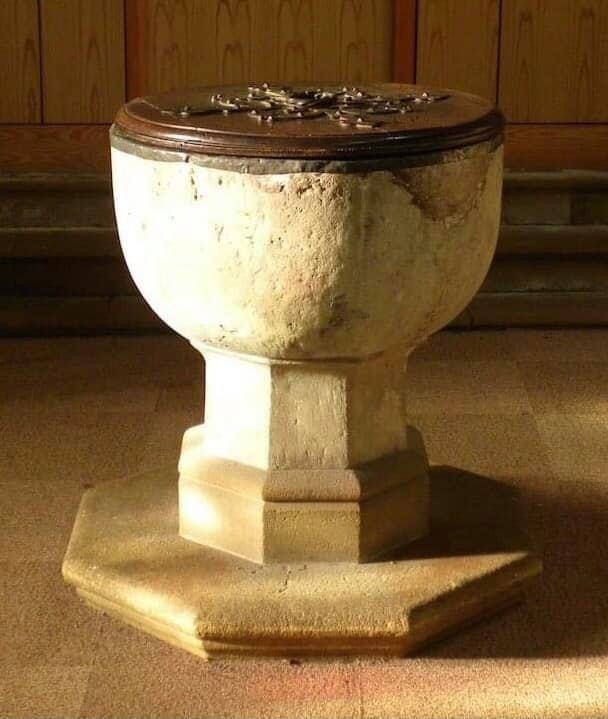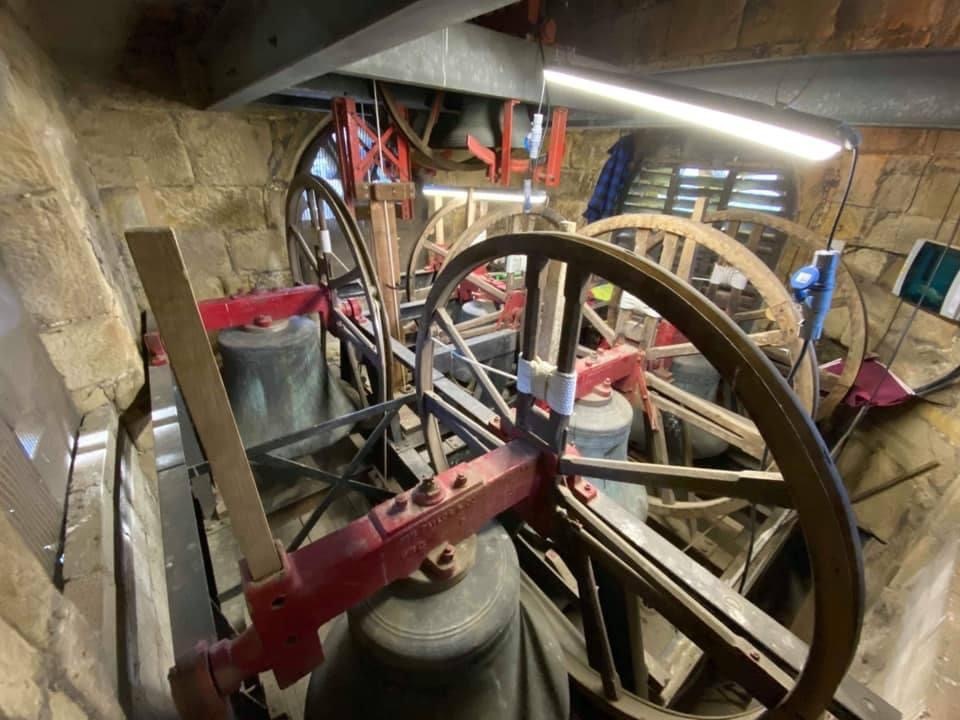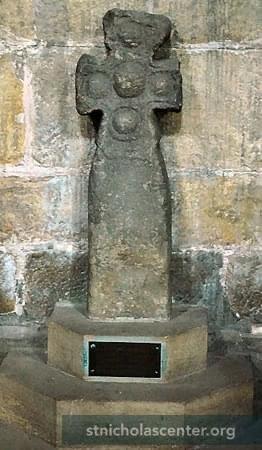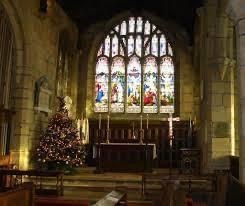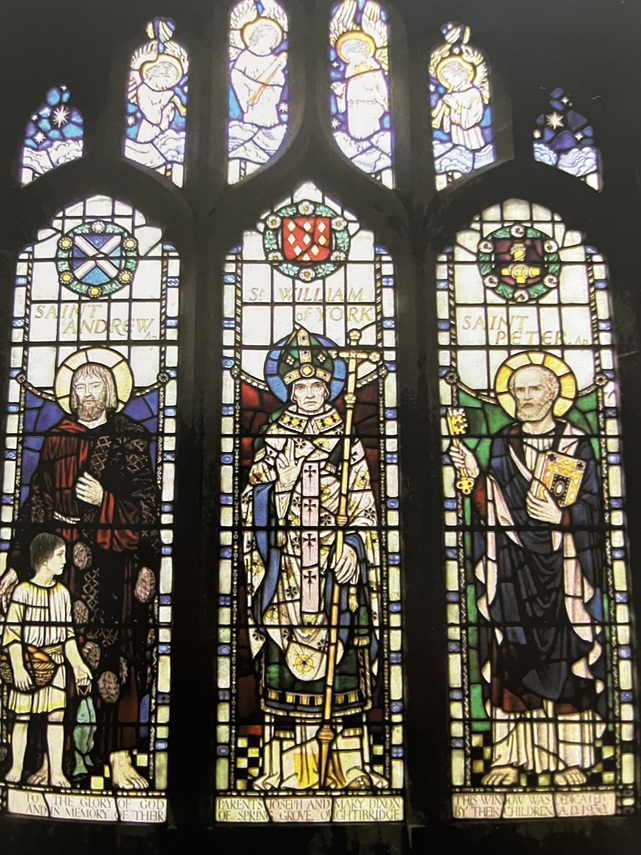A Christian Church has stood on this site for nearly 900 years and the present building is over 500 years old. During that time countless generations have worshipped God at St.Nicholas Church.
The Church is one of only 5 Grade 1 listed buildings in Sheffield, giving significant importance to this historic site.
Christian worship in the Bradfield area dates from at least the 9th century, as a Saxon cross discovered in 1870 in Low Bradfield was dated by specialists to that time. This Saxon cross still stands against the North wall in the Nave. Local historian John Wilson (1719–83) believed that the original Norman church was founded in 1109 when interpreting hieroglyphics in the church's original east window.
The Normans regarded the area around Bradfield as strategically important, highlighted by the building of the motte and bailey to the North West of the Church.
The architectural evidence suggests that the Norman church was an uncomplicated two cell building and was replaced at the beginning of the 14th century when a square bell tower was added. The Tower was largely rebuilt in the Gothic Perpendicular style during the 1480s, using some of the original masonry which consisted of local gritstone.
Originally it was a Chapel dependent on Ecclesfield Church, (the Mother Church), with visiting priests walking from Ecclesfield to Bradfield to take the services. The sunken chamber in the Eastern part of the church had a fireplace and could have been where these priests spent the night. The first Rector of St.Nicholas was Reverend Reginald Gatty, 1869-1888, and was sent by his father, the Vicar of Ecclesfield.
The oldest gravestone is thought to be the one of Henry Ibbotson from 1660.
Externally, the Church still appears the same as it did in the 15th Century, apart from 2 extra windows being added.
Internally, the Church has seen many changes during it's history.
The Font
The font is almost unique with it's simple but elegant design of a lead-lined bowl. It dates back to the 12th Century and is made of magnesium limestone from Roche Abbey Quarry. It has typical Cistercian design - noble austerity, devoid of decoration - adding credence to the local theory that it was actually made by the monks of Roche Abbey. The font was restored and replaced on a gritstone plinth in the late 19th century, when it was fitted with a new wooden lid. The modern font cover was a gift of the Boot family in 1959.
Bells
The ringing chamber can be seen from the church which is unusual. The bells used to be rung from the ground floor until the late 1980s when the back of the church was cleared of pews and the screen put in. The old screen that used to divide the ringing chamber from the church was moved at this time to screen off the new choir vestry.
In 1847 6 bells were installed, which replaced 3 ancient bells. There is no record of what happened to them, but locally it is believed that one of them was carried off to Ecclesfield and is probably now heard there.
150 years later, in 1997, 2 more bells were installed to make a ring of 8 bells. All the bells were cast and installed by Taylor’s of Loughborough. In 1996, parishioners watched the 2 new bells being cast. These 2 bells have inscriptions: ‘I will lift up mine eyes unto the hills’ and ‘I will sing unto the Lord a new song’.
Our bells are still rung today by a large team of skilled ringers and we are lucky to have one of the largest teams in Yorkshire. The ringers practice every Friday evening and ring for Sunday services and other events such as wedding etc.
Bradfield Change Ringers
l lift up mine eyes unto the hills’ and ‘I will sing unto the Lord a new song’.
Our bells are still rung today by a large team of skilled ringers and we are lucky to have one of the largest teams in Yorkshire. The ringers practice every Friday evening and ring for Services every Sunday And events such as weddings.
Saxon Cross
This is the oldest object in the church – even older than the first church on this site. Exact dating is impossible, but, comparing it with other crosses in Northern England, dates it to around the ninth century. It was probably erected to mark the earliest place of worship in pre-Norman Bradfield – this would have been an open space where wandering monks could hold simple services. It’s made of gritstone and was found in a field in Low Bradfield a few years before it was erected here in 1886. It is said to have been discovered in the grounds of The Cross Inn in Low Bradfield, which is at the bottom of Woodfall Lane opposite the cricket pitch, and is now a house. The design is not unusual – a rough and plain shaft with five bosses on the head is thought to have been a way of depicting the crucifixion by the Saxons who couldn’t bring themselves to show Christ suffering a humiliating death. The bosses are thought to represent drops of blood from Christ’s wounds.
South Porch
It is now just an entrance porch – a shelter from the weather, but when the church was built it was an important area. In the past, women had to have a service called ‘Churching’ after childbirth before they were allowed to enter the church again and this took place in the porch. Banns of marriage used to be read in the porch and the first part of funeral services as it gave people time to rest after carrying the corpse a long way. The church was a public meeting place and in medieval times archery would have been practised in the churchyard – there are grooves on the stone seats as arrows were sharpened on them.
Clergy Board
This records the Rectors of Bradfield and it situated above the large Saxon Cross.
It begins in the year 1533, which is the year Henry VIII appointed Thomas Cranmer as Archbishop of Canterbury. Following the Reformation, the number of clergy in England dropped by 50% and the standard of education was quite low. Five of the first six Anglican curates on the board used the title ‘Sir’ – no University degree. In 1869 Alfred Gatty chose his son, Reginald, to be the first Rector – Bradfield became an independent Parish. The most notable Rector of the 20th Century was Benjamin Pollard who eventually became suffragan Bishop of Lancaster and then Bishop of Sodor and Man in 1954.
Chancel Archway area
In the 1870s-1880s, there was a massive reordering of the church under it’s Rector, Reginald Gatty. The work was put in the hands of Arthur Hayball, a Sheffield craftsman who designed and constructed much of the present woodwork, including the choir stalls, pews and pulpit. He was assisted by his daughter, Clara, who was a brilliant woodcarver in her own right, and continued the unfinished woodwork on the pulpit after her father died. She carved the five intricate panels, showing Christ and the four Gospel writers – Matthew, Mark, Luke and John. Her work was paid for by John Bedford. The eagle lectern was carved by the New York firm of Robert Ellin & Co. It won a major award at the Philadelphia International Exhibition in 1876 and was presented to the church by Charles Dixon Vesey of Huntingdon, in appreciation of the training for the ministry given to his son, Eustace, in Bradfield and Ecclesfield.
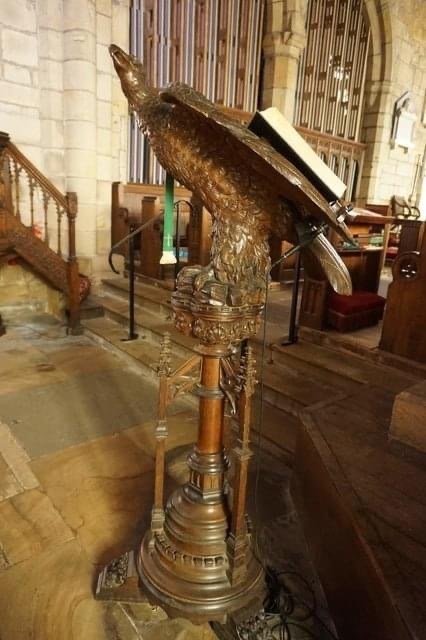
The Sanctuary
The communion, or housing benches are a memorial to the Second World War. They were too designed by G.G. Pace and were paid for by the Friends of Bradfield Church. The benches are inscribed as being in memory of three parishioners who lost their lives in WW2: Frank Crookes Pepper of Cote Farm who was lost aboard the Japanese Prisoner of War ship Lisbon Maru in 1942; Joseph Wainwright of Canyards Farm who was killed at Roumana Ridge in Tunisia in 1943; Victor Sinclair Willis of the Strines Inn who died of injuries received on air operations ‘somewhere in England’ in 1944. The oak reredos behind the altar is the result of Rev Reginald’s Gatty’s shopping spree in France. He heard a rumour that discarded former monastery fittings might be available from antique dealers in Caen, so travelled to Normandy in 1886 and duly acquired half a ton of oak panelling dating from 14th to 16th centuries. Arthur Hayball set the panelling in a frame spanning the east wall. Nine panels form a buttressed oak chest obtained at the same time were adapted to form the front and sides of the altar. Either side of the altar are 2 candlesticks, designed again by G.G. Pace, and given in 1954 in memory of Rev James Thompson (1924-38).
Screen & Organ
The screen was designed by G.G. Pace, like the font cover and the chandeliers to hide the organ. The earliest reference to an organ at Bradfield is 1621 when the chapelwardens paid 7 shillings to a man to make ‘the organs’. Organs were banned by law in 1644 and disappeared until the Restoration. In the 18th Century music was provided by a west gallery orchestra and records show that Bradfield’s gallery featured a bassoon and violincello to accompany the singers. In 1843 the orchestra was ousted and replaced with an organ, which was rebuilt in 1923. This current organ was installed in 1972-73 and was bought from a redundant Methodist church in Middlesbrough. It has 28 speaking stops and 1449 pipes. The console is in the vestry.
Tower Window - St Nicholas Window
This window is unique in style at Bradfield as the tower is older than the rest of the church. The tracery and cusps are early 14th century. It was donated by James Rimington Wilson, who’s family also donated several other windows in the church. The right hand light shows St Nicholas, our patron saint, carrying the legendary 3 golden balls and a ship’s lantern. The left light is St Cuthbert, the Northumbrian shepherd who became Bishop of Lindisfarne in 685. The head of St Oswald, which shared his coffin, can be seen in his hand. This window is one of the ten windows attributed to William Francis Dixon, who started as a designer at Clayton and Bell. There are several examples of his work at Sheffield Cathedral.
Dixon Window
As you enter the church through the main door, the most modern window in the church is second on the left. An aperture was created in the wall to accommodate this in 1930. It was given by the Dixon family to remember their mother Mary and father Joseph. In 1870 Joseph was brought from Scotland by his father and started Dixon’s Paper Mill in Oughtibridge. William, Archbishop of York, is in the centre, flanked by brothers Andrew & Peter, the fishermen who Jesus called ‘fishers of men’. In the right hand corner are tiny blue panels, indicating it was made in the prestigious Glass House studio in London, established in 1897 by a pioneering woman glazier, Mary Lowndes and her partner, John Drury. They were prominent figures in the Arts and Crafts movement.
